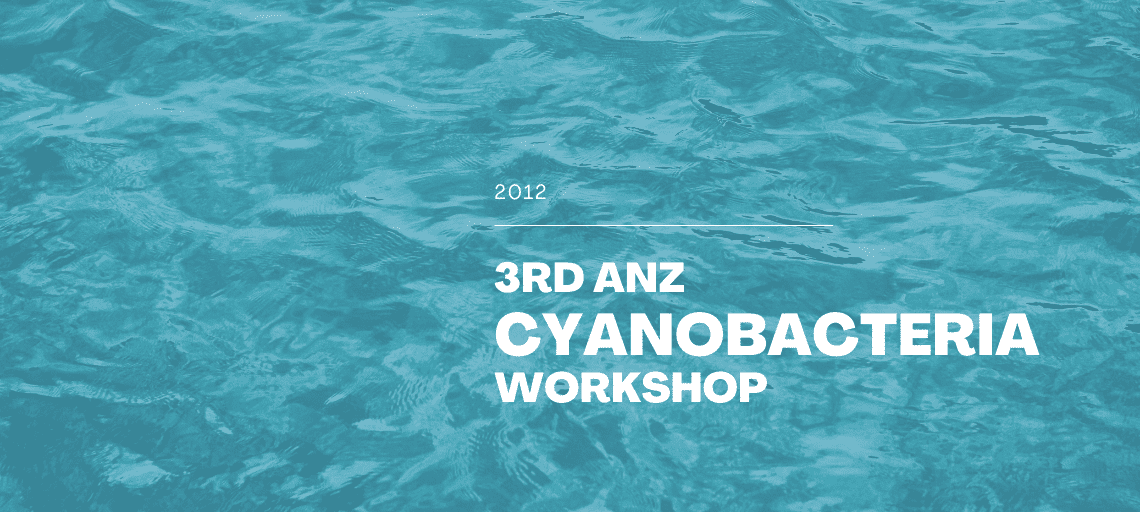The Third National Cyanobacteria Workshop was held on 23-24 August 2012 in Canberra, ACT.
This National Cyanobacterial Workshop was hosted by CSIRO’s Water for a Health Country Flagship – Ecosystems and Contaminants Theme. Thanks to Dr Carol Couch, Ecosystems and Contaminants Theme Leader, for her generous support for this workshop.
Attending the workshop were people involved in the management of public health, water resources and water supplies, and core cyanobacterial research.
The workshop was organised by Dr Tim Malthus, Research Program Leader, Environmental Earth Observation, CSIRO Land & Water Together with the following individuals who participated on the organising committee, reviewed abstracts and provided valuable advice:
- Ms Janet Anstee – CSIRO
- Dr Nagur Cherukuru – CSIRO
- Dr Erin Hestir – CSIRO
- Dr Arnold Dekker – CSIRO
- Dr Barbara Robson – CSIRO
- Dr Brad Sherman – CSIRO
- Dr Lee Bowling – NSW Office of Water
- Ms Vanora Mulvenna – Department of Health Victoria
- Ms Rachael Poon – Department of Health Victoria
- Ms Nicole Stals – CSIRO
Presenters
Roger Croome: Examining 30 years of phytoplankton data for the Murray River, with particular emphasis on the factors determining the presence and abundance of cyanobacteria
Lee Bowling: Of droughts and flooding rains – cyanobacterial presence in NSW over the past 5 summers
Tsuyoshi Kobayashi, Stephen J. Jacobs and Simon J. Hunter: Phytoplankton blooms in inland floodplain lakes
Bala Vigneswaran: Unusual Presence of Cyanobacteria: A Sydney Experience
R. Poon, V. Mulvenna, K. Dale, B. Priestly, U. Mueller, A. Humpage, G. Shaw, G. Allinson, I. Falconer and R. Dedman: Application of cyanobacterial toxin health guideline values in the Gippsland Lakes
Daryl Holland, Ryan Woodland, John Beardall and Perran Cook: What we learnt from the Gippsland Lakes Nodularia bloom of 2011-2012
Daniel Mainville: Adaptive Incident Management of the 2011/12 Toxic Blue-Green Algae Bloom in the Gippsland Lakes, Victoria
Ian R. Falconer: Cyanobacteria and Recreational Lake Management
Stuart Khan: Modelling the fate of cyanobacterial toxins in a drinking water reservoir
Grant Douglas: A new modified clay for removal of dissolved phosphorus from aquatic systems
J. Muenchhoff and B.A. Neilan: Environmental conditions that influence toxin biosynthesis in cyanobacteria
Anas Ghadouani, Elke S. Reichwaldt, Dani J. Barrington, Som Cit Sinant, Shian Min Liau and Haihong Song: Cyanotoxins as indicators of major environmental shifts in aquatic systems: Towards a comprehensive framework for the management, risk assessment and mitigation of toxic cyanobacteria
T. David Waite, The Cuong Dang, Manabu Fujii, Anna Yeung and Mark Bligh: Effect of Iron Availability on Growth and Toxicity of Microcystis Species Grown under Batch and Continuous Culture Conditions
Olivia Daniels, Larelle Fabbro, Sandrine Makiela and Catherine Bernard: Growth of the toxic cyanobacterium Limnothrix (strain AC0243) at various light intensities, temperatures and salinities
M. A. Burford, T.W. Davis, P. Muhid and M.J. Prentice: Nutrient utilisation strategies for phytoplankton in stratified subtropical reservoirs
Fariba Moslih, Jenny Davis and Lien Sim: Allelopathic activity of a freshwater macroalga, Chara australis, and a submerged macrophyte, Potamogeton crispus, on microalgae
Elke S. Reichwaldt and Anas Ghadouani: Effects of rainfall patterns on toxic cyanobacterial blooms in a changing climate: Between simplistic scenarios and complex dynamics
Susie Wood, Mark Heath, Roger Young and Ken Ryan: Toxic benthic cyanobacteria – an underestimated risk?
Richard Davis: Sharing the Water: the unfinished business of Australia’s Water Reform
Katie O’Neill, Andrew Humpage and Ian F. Musgrave: Chronic low dose exposure to saxitoxin inhibits neurite formation in model neuronal cells
Paul Whan: Identification of a novel Limnothrix sourced metabolite
Ian Stewart, Wasantha Wickramasinghe, Geoff Eaglesham, Anthony Carroll, Alan Seawright, Glenn McGregor, Glen Shaw: The cylindrospermopsin analogue deoxycylindrospermopsin: isolation, purification and acute toxicity in mice
Elvina Lee, Paul Monis, Una M. Ryan and Andrea Paparini: Performance comparison of three phylogenetic markers used for cyanobacterial identification and classification
Lyndon Llewellyn, Alison Robertson, James Burnell: Diagnostics for saxitoxins using saxiphilins
Andrew Humpage, Melody Lau, Virginie Gaget, Barbara Sendall, Somprasong Laingam: CyanoSurvey – Comparison of Methods for the Detection of Cyanobacterial Toxins
Glenn B. McGregor, Barbara C. Sendall: Cryptic toxicity: non-planktonic cyanobacteria represent a significant potential source of cyanotoxins in the freshwater environment
Jonathan Yu, Kerry Taylor, Brad Sherman: Semantics-based approach for defining complex event processing events for real-time algal bloom detection
Jennifer Dreyfus, Albane Barbero, Lionel Ho, David Dixon, Peter Scales, Werner Mobius, Jek Rozitis, Gayle Newcombe: Fate of intracellular geosmin and saxitoxins during simulated lagoon treatment of cyanobacterial sludge
Klaus D. Joehnk: Hindcasts and Prediction of algal blooms in continental Australia – an idea
Friedrich Recknagel, Philip Orr and Hongqing Cao: Inductive reasoning and prediction of population dynamics of Cylindrospermopsis in the Wivenhoe Reservoir by means of evolutionary computation
Stefania Sotora, Melody Lau, Somprasong Laingam, Andrew Humpage: Characterisation of a novel toxin from Anabaena circinalis
Milt Baker: Satellite Monitoring and Ground Sampling as a Best Management Practice for Water Quality Improvement Whole-Lake Satellite Monitoring for Total Phosphorus, Cyanobacteria and Chlorophyll-a
Tim Malthus: The case for a global inland water quality product using remote sensing
Jenny Skerratt: Modelling Lyngbya in coastal environments
Andrew Bradbury: Low Level Shellfish Toxin Detection by ULCMS-MS
Bianca Huider: Simply Unpredictable: The fickle Cyanobacteria of Lake Eppalock, Victoria



